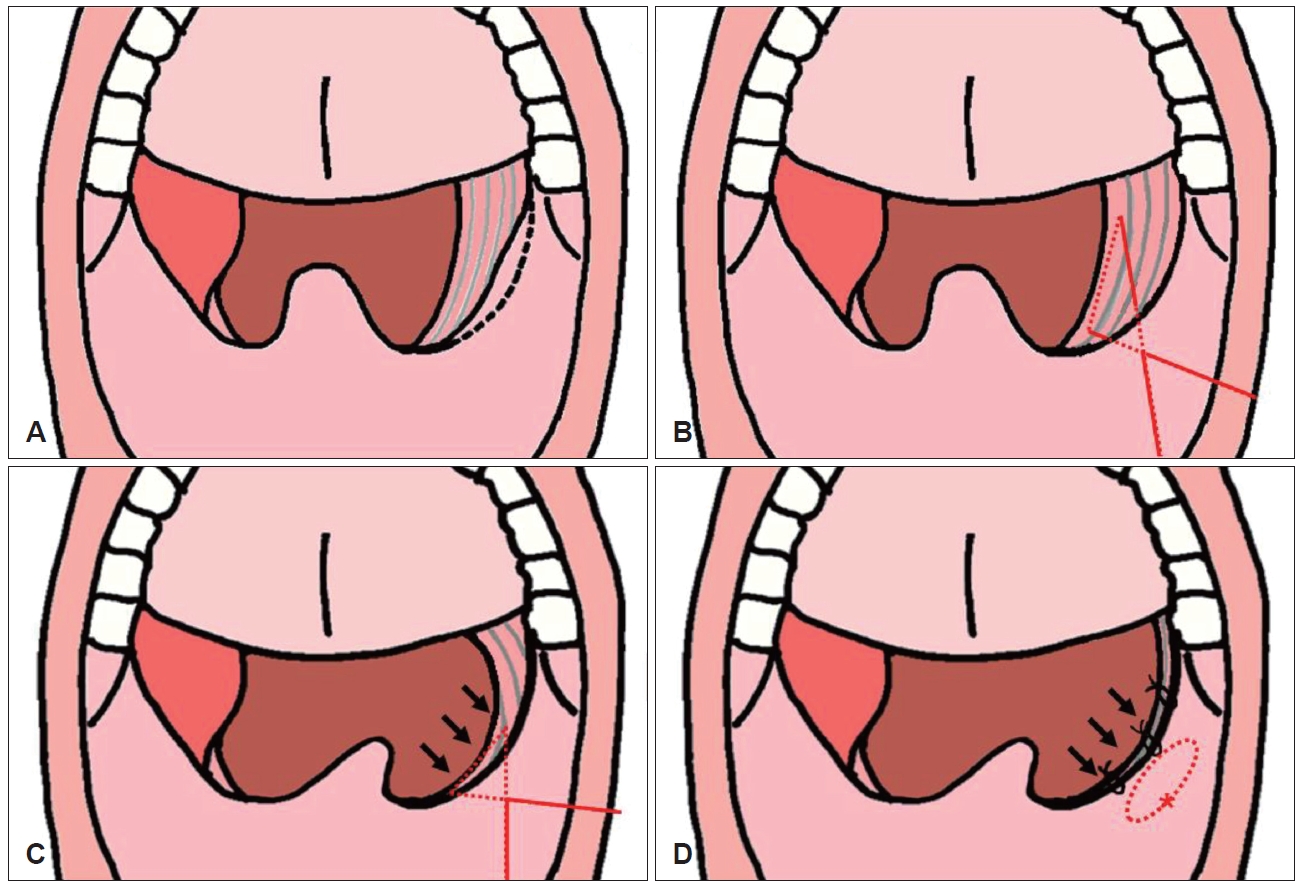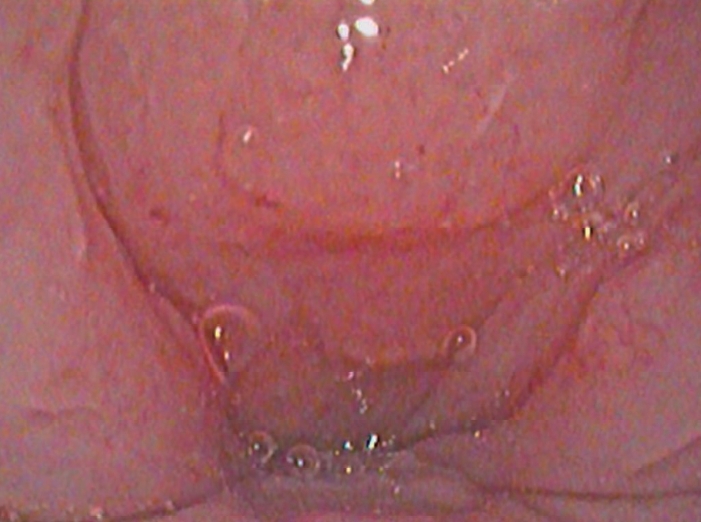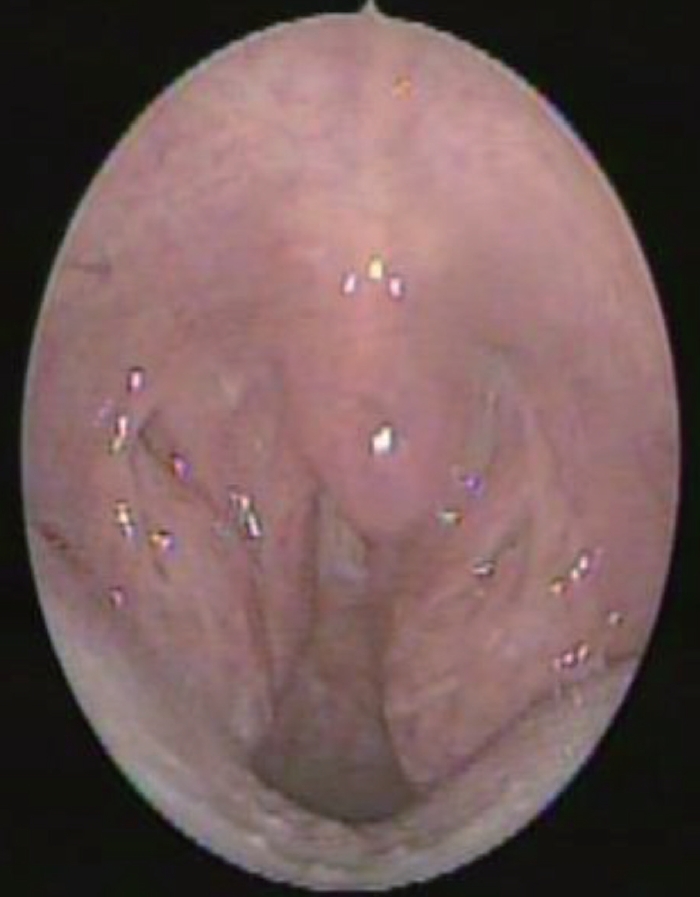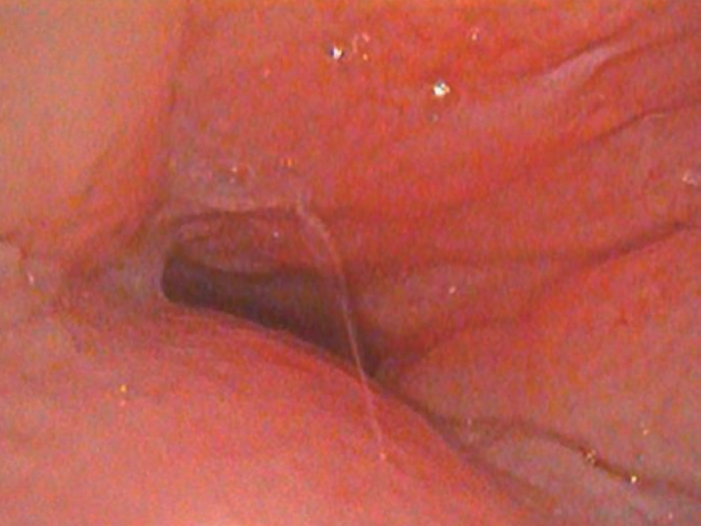 |
 |
AbstractVarious treatment modalities for obstructive sleep apnea (OSA) patients were introduced including continuous positive airway pressure (CPAP), lifestyle modification, and surgery. Numerous factors such as compliance, treatment failure, and preference should be considered when deciding the treatment. In general, patients for whom CPAP or other conservative treatment modalities failed become candidates for surgical treatments. Uvulopalatopharyngoplasty is one of the most generally performed surgeries, of which success rate is relatively low. Recently, numerous techniques that can correct lateral pharyngeal obstruction for OSA patients were introduced. However, some of them are technically difficult and aggressive. In this article, we introduce a novel surgical method for OSA called palatopharyngeal muscle suspension suture technique.
ņä£ļĪĀĒÅÉņćäņä▒ ņłśļ®┤ļ¼┤ĒśĖĒØĪņ”Ø(obstructive sleep apnea, OSA)ņØĆ ļ░śļ│ĄņĀüņØĖ ņĢ╝Ļ░ä ĻĖ░ļÅä ĒÅÉņćäņÖĆ ļ╣łļ▓łĒĢ£ ņłśļ®┤ ņżæļŗ©ņ£╝ļĪ£ ņØĖĒĢśņŚ¼ ņŗ¼Ēśł Ļ┤ĆĻ│ä ņ¦łĒÖś, ņéČņØś ņ¦ł ņĀĆĒĢś ļ░Å ņłśļ®┤ Ļ░Éņåī ļō▒ņØś ĒĢ®ļ│æņ”ØņØ┤ ļ░£ņāØĒĢśļŖö ĒØöĒĢ£ ņ¦łĒÖśņØ┤ļŗż [1,2]. ņ£Āļ│æļźĀņØĆ ļé©ņä▒ņØś ņĢĮ 22%, ņŚ¼ņä▒ņØś 17%ļĪ£ ļ│┤Ļ│ĀļÉśĻ│Ā ņ׳ļŗż [3]. ĒÅÉņćäņä▒ ņłśļ®┤ļ¼┤ĒśĖĒØĪņ”ØņØś ņ╣śļŻīļŖö ņāØĒÖ£ņŖĄĻ┤ĆĻĄÉņĀĢ, ņ¦ĆņåŹņä▒ ĻĖ░ļÅäņ¢æņĢĢĒśĖĒØĪ(continuous positive airway pressure, CPAP), ĻĄ¼Ļ░Ģ ļé┤ ņןņ╣ś ļ░Å ņłśņłĀņĀü ņ╣śļŻī ļō▒ņØś ļ░®ļ▓ĢņØ┤ ņ׳ļŗż. CPAPļŖö ĒÅÉņćäņä▒ ņłśļ®┤ļ¼┤ĒśĖĒØĪņ”ØņØś ĒÜ©Ļ│╝ņĀüņØĖ ņ╣śļŻī ļ░®ļ▓ĢņØ┤ņ¦Ćļ¦ī, ņŚ░ĻĄ¼ņŚÉ ļö░ļØ╝ ņł£ņØæļÅäĻ░Ć 17%-54%ļĪ£ ļé«Ļ▓ī ļ│┤Ļ│ĀļÉśĻ│Ā ņ׳ņ£╝ļ®░, CPAP ņ╣śļŻīĻ░Ć ņŗżĒī©ĒĢ£ ĒÖśņ×ÉļōżņŚÉĻ▓īļŖö ļŗżļźĖ ņ╣śļŻī ļ░®ļ▓ĢņØ┤ ĒĢäņÜöĒĢśļŗż [4]. CPAP, ņĢĮļ¼╝ņ╣śļŻī, ņāØĒÖ£ņŖĄĻ┤ĆĻĄÉņĀĢ ļō▒ņØś ņ╣śļŻīĻ░Ć ļ¦īņĪ▒ĒĢĀļ¦īĒĢ£ Ļ▓░Ļ│╝ļź╝ ņ¢╗ņ¦Ć ļ¬╗ĒĢ£ ĒÖśņ×ÉļōżņØĆ ņłśņłĀņĀü ņ╣śļŻīĻ░Ć ļīĆņĢłņØ┤ ļÉĀ ņłś ņ׳ļŗż [5]. ĻĖ░ļÅä ĒÅÉņćä ļČĆņ£äņØś ĒśĢĒā£ņŚÉ ļö░ļźĖ ļŗżņ¢æĒĢ£ ņłśņłĀņĀü ņ╣śļŻīĻ░Ć Ļ│ĀņĢłļÉśņŚłņ£╝ļ®░ ņłĀĒøä ļČĆņ×æņÜ®ņØä ņżäņØ┤Ļ│Ā ņä▒Ļ│ĄļźĀņØä ļåÆņØ┤ļŖö ņŚ¼ļ¤¼ ņłśņłĀ ļ░®ļ▓ĢņØ┤ ņåīĻ░£ļÉśĻ│Ā ņ׳ļŗż [6]. Ļ│ĀņŗØņĀüņØĖ ļ░®ļ▓Ģņ£╝ļĪ£ ĻĄ¼Ļ░£ņłśĻĄ¼Ļ░£ņØĖļæÉ ņä▒ĒśĢņłĀ(uvulopalatopharyngoplasty, UPPP)ņØ┤ ļäÉļ”¼ ņŗ£Ē¢ēļÉśĻ│Ā ņ׳ņ£╝ļ®░, ņĄ£ĻĘ╝ ņÖĖņĖĪ ņØĖļæÉļ▓Į ĒÅÉņćäļź╝ ĻĄÉņĀĢĒĢśĻĖ░ ņ£äĒĢ┤ lateral-expansion pharyngoplasty, expansion sphincter pharyngoplasty ļō▒ņØś ļŗżņ¢æĒĢ£ ņłśņłĀņĀü ņ╣śļŻī ļ░®ļ▓ĢņØ┤ Ļ│ĀņĢłļÉśņŚłņ£╝ļéś, ĻĖ░ņłĀņĀüņ£╝ļĪ£ ņ¢┤ļĀĄĻ│Ā ņ╣©ņŖĄņĀüņØ┤ļ®░ ņŗ£Ļ░äņØ┤ ņśżļל Ļ▒Ėļ”░ļŗżļŖö ļŗ©ņĀÉņØ┤ ņ׳ļŗż [7-9]. ļ│Ė ļģ╝ļ¼ĖņŚÉņä£ļŖö ĒÅÉņćäņä▒ ņłśļ®┤ļ¼┤ĒśĖĒØĪņ”ØņØä ņ╣śļŻīĒĢśĻĖ░ ņ£äĒĢ£ ĻĄ¼Ļ░£ņłśĻĄ¼Ļ░£ņØĖļæÉņä▒ĒśĢņłĀ ņżæ ļ╣äĻĄÉņĀü ņēĮĻ▓ī ņŗ£Ē¢ē Ļ░ĆļŖźĒĢśĻ│Ā ņĄ£ņåī ņ╣©ņŖĄņĀü ļ░®ļ▓ĢņØĖ palatopharyngeal muscle suspension suture techniqueņØä ņåīĻ░£ĒĢśĻ│Āņ×É ĒĢ£ļŗż.
ļ░®ļ▓ĢņłśņłĀ ņĀä ĒÅēĻ░Ć(Preoperative assessment)ņłśņłĀ ņĀä ĒÅēĻ░Ć Ļ│╝ņĀĢņŚÉņä£ ĒÅÉņćäņä▒ ņłśļ®┤ļ¼┤ĒśĖĒØĪņ”ØņØä ĒÅēĻ░ĆĒĢśļŖö ņØ╝ļ░śņĀüņØĖ ĒĢŁļ¬®ļōżņŚÉ ļīĆĒĢ┤ņä£ ĒÅēĻ░Ćļź╝ ņŗ£Ē¢ēĒĢśņśĆļŗż. ņłśļ®┤ļŗżņøÉĻ▓Ćņé¼(polysomnography, PSG), ņĢĮļ¼╝ņ£ĀļÅäņłśļ®┤ļé┤ņŗ£Ļ▓Į(drug-induced sleep endoscopy, DISE)ņØä ĒåĄĒĢśņŚ¼ ņłśļ®┤ņØś ņ¦łĻ│╝ ņłśļ®┤ ņŗ£ ĒÅÉņćäĻ░Ć ļ░£ņāØĒĢśļŖö ļČĆņ£äļź╝ ĒīīņĢģĒĢśņśĆļŗż. ĻĘĖ ņÖĖņŚÉļÅä ņ▓┤ņ¦łļ¤ēņ¦Ćņłś(body mass index), Brodsky ĒÄĖļÅä ļČäļźśļ▓Ģ, ļ│ĆĒśĢ Mallampati ņ▓ÖļÅäļź╝ ĒÖĢņØĖĒĢśņśĆļŗż. PSG Ļ▓Ćņé¼ Ļ▓░Ļ│╝ņŚÉņä£ļŖö ĒÅÉņćäņä▒ ņłśļ®┤ļ¼┤ĒśĖĒØĪĻ│╝ Ļ┤ĆļĀ©ļÉ£ ņłśņ╣śņØĖ apnea-hypopnea index (AHI)ņÖĆ respiratory disturbance index (RDI), lowest oxygen saturation (LSAT)ņØä ĒÖĢņØĖĒĢśņŚ¼ ņłśņłĀ ĒÜ©Ļ│╝ļź╝ ļ╣äĻĄÉĒĢĀ ņłś ņ׳ļÅäļĪØ ĒĢśņśĆļŗż. DISEļź╝ ĒåĄĒĢ┤ņä£ļŖö ĒÖśņ×ÉņØś ņÖĖņĖĪ ņØĖļæÉļČĆ ĒÅÉņćäņØś ņ£Āļ¼┤ļź╝ ĒīÉļŗ©ĒĢśņśĆĻ│Ā, Ļ░Ćņן ņŻ╝ļÉ£ ĒÅÉņćä ļČĆņ£äĻ░Ć ņ¢┤ļööņØĖņ¦Ć ĒīīņĢģĒĢĀ ņłś ņ׳ļÅäļĪØ ņŗ£Ļ░üĒÖöĒĢśļŖö Ļ▓āņŚÉ ņżæņĀÉņØä ļæÉļ®░ ĒÅēĻ░Ćļź╝ ņŗ£Ē¢ēĒĢśņśĆļŗż [10].
ņłśņłĀ ņłĀĻĖ░(Operative procedures)ņĢÖņÖĆņ£ä ņāüĒā£ņŚÉņä£ ņĀäņŗĀļ¦łņĘ©ņÖĆ ĻĖ░Ļ┤Ć ņéĮĻ┤ĆņØä ņŗ£Ē¢ēĒĢśĻ│Ā ĻĖ░Ļ┤Ć ļé┤ ĒŖ£ļĖīļź╝ ņżæņĢÖņ£╝ļĪ£ Ļ│ĀņĀĢĒĢśņśĆļŗż. ņØ┤Ēøä ĒÖśņ×ÉļŖö Rose ņ×ÉņäĖļź╝ ņĘ©ĒĢśĻ│Ā Crowe-Davis Ļ░£ĻĄ¼ĻĖ░(Medline, Northfield, IL, USA)ļź╝ ĻĄ¼Ļ░ĢņŚÉ ņ£äņ╣śĒĢśņŚ¼ ĻĄ¼ņØĖļæÉļź╝ ļģĖņČ£ņŗ£ņ╝░ļŗż. ĒÄĖļÅä Ļ▓Ėņ×ÉļĪ£ ĒÄĖļÅäļź╝ ļé┤ĒĢśņĖĪņ£╝ļĪ£ ņ×ĪņĢäļŗ╣ĻĖ░Ļ│Ā ĒÄĖļÅä ņāüĻĘ╣ņØä ņĀäĻĖ░ņåīņ×æĻĖ░ļĪ£ ņĀłĻ░£ĒĢ£ Ēøä ņĪ░ņŗ¼ņŖżļ¤ĮĻ▓ī ļ░Ģļ”¼ĒĢśņŚ¼ ĒÄĖļÅä Ēö╝ļ¦ēĻ│╝ ĒÄĖļÅäņÖĆ ņé¼ņØ┤ņØś ļ¼┤ĒśłĻ┤Ćņä▒ņØś ĒÄĖĒÅēĒĢ£ ļ®┤ņØä ļö░ļØ╝ ĒÄĖļÅäļź╝ ļ░Ģļ”¼ĒĢ£ Ēøä, ņ¢æņĖĪ ĒÄĖļÅäļź╝ ņĀłņĀ£ĒĢśĻ│Ā ļé£ ļÆż ļŗ©ĻĘ╣ ņĀäĻĖ░ņåīņ×æĻĖ░ļź╝ ņØ┤ņÜ®ĒĢśņŚ¼ ņĀäĻĄ¼Ļ░£ņäżĻČü(anterior pillar)ņØś ļé©ņØĆ ļČĆļČäņØś ņØ╝ļČĆļź╝ ņ£äņ¬Į ļČĆņ£ä Ļ▓ĮĻ│äļ®┤ņØä ļö░ļØ╝ ņĀłņĀ£ĒĢśņśĆļŗż(Fig. 1A). Monosyn 3-0 (B. Braun, Melsungen, Germany)ņØä ĻĄ¼ņ╣śĒøäņé╝Ļ░ü(retromolar trigone) ļČĆņ£äņŚÉņä£ ņĀÉļ¦ēĒĢśļĪ£ ĒåĄĻ│╝ņŗ£ņ╝£ ĒÄĖļÅäņÖĆņØś ņāüņĖĪņ£╝ļĪ£ ļéśņś¼ ņłś ņ׳ļÅäļĪØ ĒĢśņśĆļŗż. ņØ┤Ēøä ĒÄĖļÅäņÖĆ ļ░öļŗźņØś ĻĄ¼Ļ░£ņØĖļæÉĻĘ╝(palatopharyngeus muscle)ņØä ņłśņ¦ü ļ░®Ē¢źņ£╝ļĪ£ Ļ░ĆļŖźĒĢ£ ļäōĻ▓ī ņĢĮ 2 cm ņĀĢļÅä Ļ▒ĖĻ│Ā ļéśņä£ ņĀÉļ¦ēĒĢśļź╝ ĒåĄĒĢśņŚ¼ ņ▓śņØī ļōżņ¢┤Ļ░öļŹś ĻĄ¼ņ╣śĒøäņé╝Ļ░üņ£╝ļĪ£ ļéśņś¼ ņłś ņ׳ļÅäļĪØ ĒĢśņśĆļŗż(Fig. 1B). ņĀüļŗ╣ĒĢ£ ĻĖ┤ņןņØä ņ£Āņ¦ĆĒĢ£ ņ▒äļĪ£ Ļ▓░ņ░░ņØä ņŗ£Ē¢ēĒĢśņśĆĻ│Ā, ĻĄ¼Ļ░£ļČĆ ņĪ░ņ¦üņØ┤ ņĀäņÖĖņāüļ░®ņ£╝ļĪ£ ļŗ╣Ļ▓©ņ¦ĆļŖö Ļ▓āņØä ĒÖĢņØĖĒĢĀ ņłś ņ׳ņŚłļŗż(Fig. 1C). ļ¦łņ¦Ćļ¦ēņ£╝ļĪ£ Vicryl 4-0 (Ethicon Inc., Raritan, NJ, USA)ņØä ņé¼ņÜ®ĒĢśņŚ¼ ĻĄ¼Ļ░£ņØĖļæÉĻĘ╝Ļ│╝ ĻĄ¼Ļ░£ņäżĻĘ╝(palatoglossus muscle)ņØä 3-4ĒÜī ņĀĢļÅä ļ┤ēĒĢ®ĒĢśņŚ¼ ĻĄ¼Ļ░£ĒøäļČĆņØś ĻĖ░ļÅä ĒÖĢņןņØä ņ£äĒĢ£ ņĀüļŗ╣ĒĢ£ ĻĖ┤ņןņØä ņ£Āņ¦ĆĒĢĀ ņłś ņ׳ļÅäļĪØ ĒĢśņśĆļŗż(Fig. 1D) (Supplementary Video 1).
ņłśņłĀ Ēøä Ļ┤Ćļ”¼(Postoperative care)ņłśņłĀ Ēøä Ļ┤Ćļ”¼ļŖö Ļ│ĀņŗØņĀüņØĖ ĻĄ¼Ļ░£ņłśĻĄ¼Ļ░£ņØĖļæÉņä▒ĒśĢņłĀņØä ņŗ£Ē¢ēĒĢ£ ĒÖśņ×ÉņÖĆ ļŗżļź┤ņ¦Ć ņĢŖĻ▓ī ņØ╝ļ░śņĀüņØĖ ņłśņłĀ Ēøä ļéśĒāĆļéĀ ņłś ņ׳ļŖö ĒåĄņ”Ø ļ░Å ĻĄ¼ņŚŁĻ░É, ļ│Ćļ╣ä ļō▒ņØś ņ”ØņāüņŚÉ ļīĆĒĢ£ ņ”Øņāü ņĪ░ņĀłņØä ņŗ£Ē¢ēĒĢśņśĆļŗż. ļśÉĒĢ£ ņłśņłĀ ĒøäņŚÉ ļ░£ņāØ Ļ░ĆļŖźĒĢ£ ņłśņłĀ ļČĆņ£ä ļČĆņóģņŚÉ ļīĆĒĢ£ ĒÅēĻ░Ć ļ░Å ņłśņłĀ ļČĆņ£ä ņČ£Ēśł ņ£Āļ¼┤ļź╝ ĒīÉļŗ©ĒĢśĻĖ░ ņ£äĒĢ┤ņä£ ņŻ╝ĻĖ░ņĀüņ£╝ļĪ£ ĒøäļæÉļé┤ņŗ£Ļ▓ĮņØä ņ┤¼ņśüĒĢśņśĆļŗż. ĒÖśņ×ÉļŖö ņłśņłĀ Ēøä 3ņØ╝Ļ░ä ņ×ģņøÉ ņ╣śļŻīļź╝ ļ░øņØĆļÆż ņØ╝ņāü ņāØĒÖ£ņØ┤ Ļ░ĆļŖźĒĢśļŗżĻ│Ā ĒīÉļŗ©ļÉśņ¢┤ Ēć┤ņøÉĒĢśņśĆļŗż. Palatopharyngeal muscle suspension sutureņŚÉ ņé¼ņÜ®ĒĢśņśĆļŹś monosynņØĆ mucosa ļé┤ļČĆļĪ£ ļ¦żļ¬░ļÉśņ¢┤ ņ£ĪņĢłņĀüņ£╝ļĪ£ Ļ┤Ćņ░░ļÉśņ¦Ć ņĢŖņĢśĻ│Ā, ņ¦ĆņåŹņĀüņØĖ ĻĖ┤ņן ņ£Āņ¦Ćļź╝ ņ£äĒĢśņŚ¼ ļ┤ēĒĢ®ņØä ļ░£ņé¼ĒĢśņ¦Ć ņĢŖņĢśļŗż. ĻĄ¼Ļ░£ņØĖļæÉĻĘ╝Ļ│╝ ĻĄ¼Ļ░£ņäżĻĘ╝ņØä ļ┤ēĒĢ®ĒĢ£ Vicryl 4-0ļÅä ĒØĪņłśņä▒ ļ┤ēĒĢ®ņé¼ļĪ£ ņ×ÉņŚ░ņŖżļ¤ĮĻ▓ī ļģ╣ņØä ņłś ņ׳ļÅäļĪØ ļæÉņŚłļŗż.
ņłśņłĀ Ēøä Ļ▓░Ļ│╝(Postoperative result)ņłśņłĀ ņĀä ņłśļ®┤ļŗżņøÉĻ▓Ćņé¼ Ļ▓░Ļ│╝ AHIļŖö 57.5ĒÜī/hr, RDIļŖö 58.8ĒÜī/hr, LSATļŖö 79%ļĪ£ ĒÖĢņØĖļÉśņŚłļŗż(Table 1). ņłśņłĀ ņĀä ņĢĮļ¼╝ņ£ĀļÅä ņłśļ®┤ļé┤ņŗ£Ļ▓ĮņāüņŚÉņä£ļŖö ĻĄ¼Ļ░£ņłś ļ░Å ņÖĖņĖĪ ņØĖļæÉļ▓ĮņØś ĻĄ¼ņŗ¼ņä▒ ĒśĢĒā£ņØś ņÖäņĀäĒĢ£ ĒÅÉņćäĻ░Ć ĒÖĢņØĖļÉśņŚłņ£╝ļ®░, Ļ▓Ćņé¼ ņŗ£Ē¢ē ņżæ ņĮöĻ│©ņØ┤ ļ░Å ļ¼┤ĒśĖĒØĪņØä ĒÖĢņØĖĒĢĀ ņłś ņ׳ņŚłļŗż(Fig. 2). ņłśņłĀ ņĀä ĻĄ¼Ļ░Ģ ļé┤ ļé┤ņŗ£Ļ▓Į ņåīĻ▓¼ņāü ņ¢æņĖĪ ĒÄĖļÅäņØś ļ╣äļīĆ, ņäżĻĘ╝ļČĆ ļ╣äļīĆņÖĆ ĒĢ©Ļ╗ś ņāüļīĆņĀüņ£╝ļĪ£ ĻĖĖĻ│Ā ļæÉĻ║╝ņÜ┤ ĻĄ¼Ļ░£ņłśļĪ£ ņØĖĒĢ£ ĻĖ░ļÅäņØś Ēśæņ░®ņØ┤ Ļ┤Ćņ░░ļÉśņŚłļŗż(Fig. 3). ĒÖśņ×ÉļŖö ņłśņłĀ ņĀä ņŻ╝Ļ┤ĆņĀüņØĖ ņ”Øņāüņ£╝ļĪ£ ņĮöļ¦ēĒל ļ░Å ņĮöĻ│©ņØ┤, ņŻ╝Ļ░ä ņĪĖļ”╝ņ”Ø, Ļ░£ņÜ┤ĒĢśņ¦Ć ļ¬╗ĒĢ£ ņłśļ®┤ ļ░Å ļČłļ®┤, Ēö╝ļĪ£Ļ░É ļō▒ņØä ĒśĖņåīĒĢśņśĆļŗż. ņłśņłĀ Ēøä 3Ļ░£ņøö ļÆżņŚÉ ņłśļ®┤ļŗżņøÉĻ▓Ćņé¼, ņĢĮļ¼╝ņ£ĀļÅä ņłśļ®┤ļé┤ņŗ£Ļ▓Į ņŗ£Ē¢ē ļ░Å ņ”Øņāü ĒśĖņĀä ņ£Āļ¼┤ņŚÉ ļīĆĒĢ£ ĒÅēĻ░Ćļź╝ ņŗ£Ē¢ēĒĢśņśĆļŗż. ņłśņłĀ Ēøä ņłśļ®┤ ļŗżņøÉĻ▓Ćņé¼ Ļ▓░Ļ│╝ AHI 23.9ĒÜī/hr, RDI 26ĒÜī/hr, LSAT 88%ļĪ£ ļīĆļČĆļČäņØś ņ¦ĆĒæ£Ļ░Ć Ļ░£ņäĀļÉ£ ņłśņ╣śļź╝ ļ│┤ņśĆļŗż(Table 1). ņłĀĒøä ņĢĮļ¼╝ ņ£ĀļÅäņłśļ®┤ ļé┤ņŗ£Ļ▓Įņāü ņłĀņĀä Ļ▓Ćņé¼ņÖĆ ļ╣äĻĄÉĒĢ┤ ĻĄ¼Ļ░£ņłśņØś ĒÅÉņćäļŖö ĒÖĢņØĖļÉśņ¦Ć ņĢŖņĢśņ£╝ļ®░ ņÖĖņĖĪ ņØĖļæÉļ▓ĮņØś ļ»ĖņĢĮĒĢ£ ĻĄ¼ņŗ¼ņä▒ ĒśĢĒā£ņØś ĒÅÉņćäĻ░Ć ņ׳ņŚłļŗż(Fig. 4). ņŻ╝Ļ░ä ņĪĖļ”╝ņ”Ø, Ēö╝ļĪ£Ļ░É ļō▒ ņłśņłĀ ņĀä ļŖÉļü╝ļŹś ņŻ╝Ļ┤ĆņĀü ņ”Øņāü ļ¬©ļæÉ ĒśĖņĀäļÉśņŚłļŗż. ņłśņłĀ Ēøä ĻĄ¼Ļ░Ģ ļé┤ ļé┤ņŗ£Ļ▓Į ņåīĻ▓¼ņāü ņłśņłĀ ņĀäņŚÉ ļ╣äĒĢ┤ ļ╣äņØĖļæÉĻ░ĢņØ┤ ļ¦ÄņØ┤ ļäōņ¢┤ņ¦ä Ļ▓āņØä ņĢī ņłś ņ׳ņŚłļŗż(Fig. 5). ņłĀĒøä 6Ļ░£ņøöņ¦Ė ļ╣äņØĖļæÉĻ░Ģ ņØ┤ļ¼╝Ļ░É ļō▒ņØś ĒĢ®ļ│æņ”Ø ņŚåņØ┤ Ļ┤Ćņ░░ ņżæņØ┤ļŗż.
Ļ▓░Ļ│╝Lateral-expension pharyngoplastyļŖö ņāüņØĖļæÉņłśņČĢĻĘ╝(superior pharyngeal constrictor muscle)ņØś ņĀłņĀ£ ļ░Å ĒÜīņĀäņØä ĒżĒĢ©ĒĢśņŚ¼ ĻĄ¼Ļ░£Ēö╝ĒīÉņØä Z-ņä▒ĒśĢņ£╝ļĪ£ ļäōĒśĆņŻ╝ļŖö ņłĀņŗØņ£╝ļĪ£ ņĀĢņāü ĒĢ┤ļČĆĒĢÖņĀü ĻĘ╝ņ£Ī ĻĄ¼ņĪ░ļ¼╝ņŚÉ ņāüļŗ╣ĒĢ£ ļ│ĆĒśĢņØä Ļ░ĆĒĢśļŖö ņłĀņŗØņØ┤ļŗż. ņłśļ®┤ ļŗżņøÉĻ▓Ćņé¼ Ļ▓░Ļ│╝ļŖö Ļ│ĀņŗØņĀüņØĖ UPPPļ│┤ļŗż ĒÜ©Ļ│╝ņĀüņØ┤ļéś ņŚ░ĒĢśĻ│żļ×Ć, ĻĄ¼Ļ░£ņØĖļæÉĻĖ░ļŖźļČĆņĀä(velopharyngeal insufficiency), ņāüņ▓ś ļ▓īņ¢┤ņ¦É ļō▒ņØś ļČĆņ×æņÜ®ņØ┤ ņĪ░ĻĖł ļŹö ļ░£ņāØĒĢśļŖö Ļ▓āņ£╝ļĪ£ ļ│┤Ļ│ĀļÉśņŚłļŗż [9]. Expansion sphincter pharyngoplastyļŖö ĻĄ¼Ļ░£ņØĖļæÉĻĘ╝ņØś ĒĢśļČĆņØś ņØ╝ļČĆļČäņØä ņĀłņĀ£ĒĢśņŚ¼ ĻĘ╝ņ£ĪņØä ņØ┤ļÅÖņŗ£ņ╝£ ņĀäļ░®, ņāüņÖĖņĖĪņ£╝ļĪ£ ļÅīļ”¼ļŖö ņłĀņŗØņØ┤ļŗż [10].
Single suspension sutureļŖö ĻĄ¼Ļ░£ņØĖļæÉĻĘ╝ņØś Ļ░Ćņן ņāüļČĆ ļČĆņ£äņŚÉņä£ ļ┤ēĒĢ®ņØä ņŗ£ņ×æĒĢśņŚ¼ ņØĄļÅīĻĄ¼(pterygoid hamulus) ĻĘ╝ņ▓śņŚÉņä£ ĻĄ¼Ļ░£ņäżĻĘ╝ņØä ĒåĄĻ│╝ĒĢśļ®┤ņä£ ĒÄĖļÅäņÖĆņŚÉņä£ ļ┤ēĒĢ®ņØä ĒĢśņŚ¼ ĻĖ┤ņןņØä ĒśĢņä▒ĒĢśļŖö ņłĀņŗØņØ┤ļŗż [11]. ļ¦łņ░¼Ļ░Ćņ¦ĆļĪ£ pterygomandibular suspension sutureļŖö ņØĄļÅīĻĄ¼ ļåÆņØ┤ņŚÉņä£ ņØĄļÅīĒĢśņĢģļČĆ(pterygomandibular) Ļ░ĆņĖĪņŚÉņä£ ņŗ£ņ×æĒĢśņŚ¼ ĒøäĻĄ¼Ļ░£ņäżĻČü(posterior pillar)ļź╝ ĒåĄĻ│╝ĒĢ┤ņä£ ĻĄ¼Ļ░£ņØĖļæÉĻĘ╝Ļ│╝ ĒøäĻĄ¼Ļ░£ņäżĻČü Ēö╝ĒīÉņØä Ļ▒ĖĻ│Ā ņØĄļÅīĻĄ¼ ļé┤ņĖĪņ£╝ļĪ£ ļÅīņĢäņÖĆņä£ ĻĖ┤ņןņØä ĒśĢņä▒ĒĢśļŖö ņłĀņŗØņØ┤ļŗż [12].
ņØ┤ļ¤¼ĒĢ£ ņĀÉņŚÉņä£ palatopharyngeal suspension sutureļŖö expension phayrngoplastyņÖĆļŖö ļŗżļź┤Ļ▓ī ņØĖļæÉĻĘ╝ņ£ĪņØä ņĀłņĀ£ĒĢśĻ▒░ļéś ĒÜīņĀäĒĢśņŚ¼ ņØĖļæÉļČĆļź╝ ĒÖĢņןĒĢśļŖö Ļ▓āņØ┤ ņĢäļŗłļØ╝ ļ╣äĻĄÉņĀü ļŹ£ ņ╣©ņŖĄņĀüņØĖ ļ░®ļ▓ĢņØĖ ļ┤ēĒĢ®ņé¼ļź╝ ĒåĄĒĢ┤ ĻĖ┤ņןņØä Ļ░ĆĒĢ£ļŗż. ļö░ļØ╝ņä£ ņĀĢņāü ĒĢ┤ļČĆĒĢÖņĀü ĻĄ¼ņĪ░ļź╝ ņ£Āņ¦ĆĒĢĀ ņłś ņ׳ņ£╝ļ®░, ļČĆņ×æņÜ®ņØś Ļ░ĆļŖźņä▒ļÅä ļé«ņØä Ļ▓āņ£╝ļĪ£ ĒīÉļŗ©ļÉ£ļŗż.
ĒāĆ ļģ╝ļ¼ĖņŚÉņä£ ņåīĻ░£ĒĢśļŖö suspension suture ņłĀņŗØļōżĻ│╝ ļ│Ė ļģ╝ļ¼ĖņØś palatopharyngeal suspension sutureņÖĆ ņ£Āņé¼ĒĢ£ ņĀÉņØ┤ ņ׳ņ¦Ćļ¦ī, ĒāĆ suspension sutureļŖö ĻĄ¼Ļ░£ņØĖļæÉĻĘ╝ņŚÉ ĻĖ┤ņןļÅäļź╝ Ļ░ĆĒĢśļŖö ņ¦ĆņĀÉņØ┤ ĒĢśļéśņØś ņĀÉņØ┤ļØ╝ļŖö Ļ▓āņØä Ļ░Ćņן Ēü░ ņ░©ņØ┤ņĀÉņ£╝ļĪ£ ļ│╝ ņłś ņ׳ļŗż. Single suspension sutureļŖö ņØ┤ņÖĆ Ļ░ÖņØĆ ļŗ©ņĀÉņØä ĻĘ╣ļ│ĄĒĢśĻĖ░ ņ£äĒĢ┤ņä£ double suspension sutureļź╝ ņŗ£Ē¢ēĒĢśņŚ¼ ņ▓śņØī ņŗ£Ē¢ēĒĢ£ ļ┤ēĒĢ® ļČĆņ£äļ│┤ļŗż ņÖĖņĖĪĒĢśļ░® ļČĆņ£äļĪ£ ņ£Āņé¼ĒĢ£ ļ░®ņŗØņ£╝ļĪ£ ĒĢ£ ļ▓ł ļŹö ļ┤ēĒĢ®ņØä ņŗ£Ē¢ēĒĢ£ļŗż [13]. Palatopharyngeal suspension sutureļŖö ĒĢ£ ļ▓łņØś ļ┤ēĒĢ®ņ£╝ļĪ£ ĻĄ¼Ļ░£ņØĖļæÉĻĘ╝ņØś ņāüļČĆļČĆĒä░ ĒĢśļČĆĻ╣īņ¦Ć ĒĢśļéśņØś ņĀÉņØ┤ ņĢäļŗī ņĀäļ░śņĀüņØĖ ĻĘ╝ņ£Īļ®┤(plane)ņ£╝ļĪ£ ĻĖ┤ņןļÅäļź╝ ņŻ╝ļ®┤ņä£ Ļ▓¼ņØĖĒĢĀ ņłś ņ׳ļŗżļŖö ņןņĀÉņØ┤ ņ׳ļŗż(Fig. 1C). ņØ┤ļ¤░ ņĀÉņŚÉņä£ ĒāĆ suspension sutureļ│┤ļŗż palatopharyngeal suspension sutureļŖö ĻĄ¼Ļ░£ņØĖļæÉĻĘ╝ņŚÉ ĻĖ┤ņןļÅäļź╝ ļŹö ļäōĻ▓ī ņżä ņłś ņ׳ņ£╝ļ®░, ņłĀĻĖ░ņØś ņŗ£Ļ░äļÅä ļŗ©ņČĢĒĢĀ ņłś ņ׳ļŗż.
Ļ▓░ļĪĀņĀüņ£╝ļĪ£ ļ│Ė ņŚ░ĻĄ¼ņŚÉņä£ ņåīĻ░£ĒĢ£ palatopharyngeal muscle suspension suture techniqueņØĆ ļŗżļźĖ ņłĀĻĖ░ņŚÉ ļ╣äĒĢ┤ ņĄ£ņåī ņ╣©ņŖĄņĀüņØ┤ļ®░, ņłĀĻĖ░Ļ░Ć ņ¢┤ļĀĄņ¦Ć ņĢŖņĢä ņ┤łņŗ¼ņ×ÉļÅä ņēĮĻ│Ā ļ╣Āļź┤Ļ▓ī ņŗ£Ē¢ēĒĢĀ ņłś ņ׳Ļ│Ā, ļśÉĒĢ£ Ļ░ĆņŚŁņĀüņØ┤ļØ╝ļŖö ņןņĀÉņØ┤ ņ׳ļŗż. ņØ┤ņŚÉ ņĀĆņ×ÉļōżņØĆ ņØ┤ ņłĀĻĖ░Ļ░Ć ĒÅÉņćäņä▒ ņłśļ®┤ļ¼┤ĒśĖĒØĪņ”ØņØś ņłĀĒøä ņä▒Ļ│ĄļźĀņØä ļåÆņØ╝ ņłś ņ׳ļŖö ņČöĻ░ĆņĀüņØĖ ņłĀņŗØ ņżæņØś ĒĢśļéśĻ░Ć ļÉĀ Ļ▓āņØ┤ļØ╝Ļ│Ā ņĀ£ņĢłĒĢśļŖö ļ░öņØ┤ļŗż.
Supplementary MaterialThe Data Supplement is available with this article at https://doi.org/10.3342/kjorl-hns.2021.00843.
NotesAuthor Contribution Conceptualization: Jae Hwan Kwon. Data curation: Dong Woo Lee, Joo Yeon Kim. Supervision: Jae Hwan Kwon. Validation: Jae Hwan Kwon. Visualization: Dong Gyu Choi, Donw Woo Lee. WritingŌĆöoriginal draft: Dong Gyu Choi. WritingŌĆöreview & editing: Joo Yeon Kim, Jae Hwan Kwon. Fig.┬Ā1.Operation procedure illustrations. A: Right tonsillectomy was completed and part of anterior pillar mucosa resection was done. B: Suspension suture of palatopharyngeus muscle. C: Widening of lateral pharyngeal wall can be observed when tension is applied. D: Suture with Vicryl 4-0 (Ethicon Inc.) between palatopharyngeus muscle and palatoglossus muscle. 
Fig.┬Ā2.Preoperative drug-induced sleep endoscopy. Complete concentric obstruction of uvula and lateral pharyngeal wall was identified. Snoring and apnea were present. 
Fig.┬Ā3.Preoperative endoscopic finding. Bilateral palatine tonsillar hypertrophy, tongue base hypertrophy, elongation of uvula was observed. 
Fig.┬Ā4.Postoperative drug-induced sleep endoscopy. Relatively expanded airway with mild concentric obstruction of lateral pharyngeal wall was identified. 
Fig.┬Ā5.Postoperative endoscopic finding. Compared with preoperative finding, pharyngeal cavity dilatation was recognized. 
REFERENCES1. Chung S, Yoon IY, Shin YK, Lee CH, Kim JW, Ahn HJ. Endothelial dysfunction and inflammatory reactions of elderly and middle-aged men with obstructive sleep apnea syndrome. Sleep Breath 2009;13(1):11-7.
2. Peppard PE, Young T, Barnet JH, Palta M, Hagen EW, Hla KM. Increased prevalence of sleep-disordered breathing in adults. Am J Epidemiol 2013;177(9):1006-14.
3. Franklin KA, Lindberg E. Obstructive sleep apnea is a common disorder in the population-a review on the epidemiology of sleep apnea. J Thorac Dis 2015;7(8):1311-22.
4. Weaver TE, Grunstein RR. Adherence to continuous positive airway pressure therapy: The challenge to effective treatment. Proc Am Thorac Soc 2008;5(2):173-8.
5. Tanna N, Smith BD, Zapanta PE, Karanetz I, Andrews BT, Urata MM, et al. Surgical management of obstructive sleep apnea. Plast Reconstr Surg 2016;137(4):1263-72.
6. Carvalho B, Hsia J, Capasso R. Surgical therapy of obstructive sleep apnea: A review. Neurotherapeutics 2012;9(4):710-6.
7. Hong SN, Kim HG, Han SY, Ji JY, Kim MK, Han DH, et al. Indications for and outcomes of expansion sphincter pharyngoplasty to treat lateral pharyngeal collapse in patients with obstructive sleep apnea. JAMA Otolaryngol Head Neck Surg 2019;145(5):405-12.
8. Cahali MB. Lateral pharyngoplasty: A new treatment for obstructive sleep apnea hypopnea syndrome. Laryngoscope 2003;113(11):1961-8.
9. Pang KP, Woodson BT. Expansion sphincter pharyngoplasty: A new technique for the treatment of obstructive sleep apnea. Otolaryngol Head Neck Surg 2007;137(1):110-4.
10. Oh MS, Dedhia RC. Current techniques and role of drug-induced sleep endoscopy for obstructive sleep apnea. Curr Sleep Medicine Rep 2017;3:152-63.
11. El-Ahl MA, El-Anwar MW. Expansion pharyngoplasty by new simple suspension sutures without tonsillectomy. Otolaryngol Head Neck Surg 2016;155(6):1065-8.
|
|
||||||||||||||||||||||||||||||||||||||||||||||

 |
 |